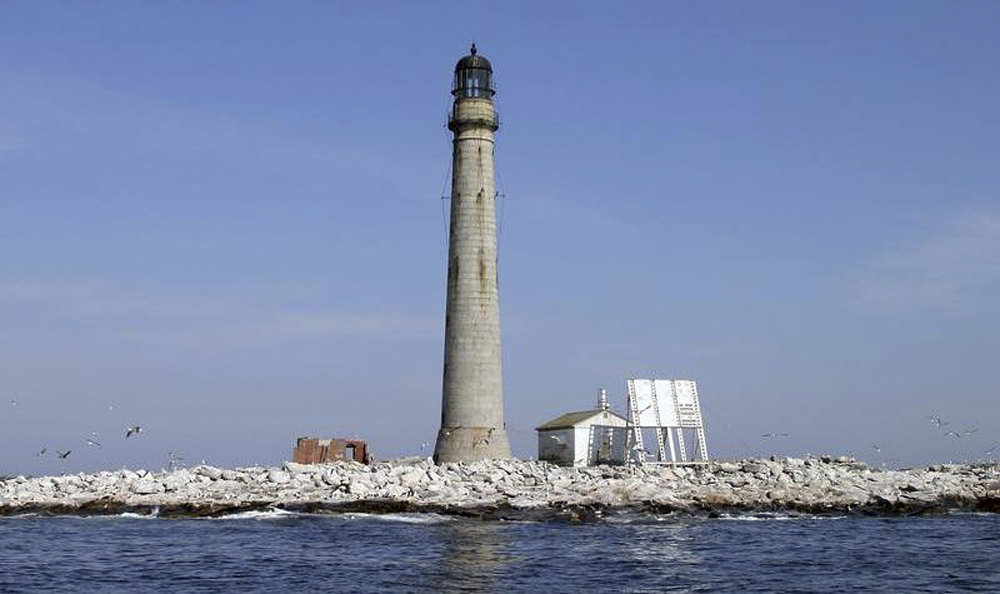A lonely granite tower on a barren outcropping off Cape Neddick has triggered a bidding war for ownership rights.
The deadline for bidding on Boon Island Light Station was extended from Saturday until Sunday morning by the U.S. General Services Administration.
Bidding had been scheduled to close Tuesday but was extended several times as 13 bidders kept pushing up the price.
On Saturday morning the bidding reached $78,000, up from $55,000 on Wednesday.
Boon Island station may be the tallest lighthouse in New England but it seems an unlikely spot to trigger a bidding war. The 133-foot granite tower six miles off the coast of York was built in 1855 on a 1-acre, wave-worn ledge that reaches just 14 feet above sea level. The property also includes the ruins of the light keeper’s house and an old shed.
“It is difficult to access. These are the very ones the Coast Guard is getting rid of,” said James Hyland, founder of The Lighthouse Preservation Society of Dover, New Hampshire, which helped put lighthouse preservation on the map in the 1980s.
The bidding war could continue for some time. The GSA reserves the right to continue to extend the auction.
The federal government is also auctioning Halfway Rock Light Station about 10 miles off Harpswell in Casco Bay.
Three bidders brought the price of the 143-year-old facility with a 76-foot tower on two acres of ledge to $56,000 as of Saturday morning. No bidding deadline has been set by the GSA for Halfway Rock Light.
The two lighthouses were put on the auction block in May as part of a federal program aimed at shedding some of the costs of maintaining lighthouses in the U.S. The Coast Guard will continue to provide some maintenance on the lighthouses, which will remain aids for marine navigation.
Both Maine lighthouses are on the National Register of Historic Places.
The federal government has sold off more than 100 lighthouses since 2000. Sixty-eight were transferred for free to preservation groups and 36 were sold at auctions.
Hyland said the Boon Island and Halfway Rock lighthouses are remote, difficult to land on and will be expensive to maintain.
“The new owners better have deep pockets and be darn good boaters,” said Hyland.
He said Boon Island light has a colorful history that could make it attractive as a piece of real estate.
Boon Island was the scene of the shipwreck of the Nottingham Galley in 1710. Survivors were said to have cannibalized one of their deceased shipmates. One of the lighthouse keepers had to stow the body of his wife in a shed for the winter because the weather was so bad he couldn’t row to shore.
“Many lighthouses are steeped in history and lore but Boon Island is one of those few that speaks to storms and shipwrecks and isolation,” said Bob Trapani, executive president of the American Light House Foundation of Rockland.
Trapani’s organization has preserved 18 lighthouses along the New England coast. He said his group eyed both the Boon Island and Halfway Rock structures for preservation but couldn’t find partner organizations to join with them. The project was just too expensive to do alone, said Trapani.
Trapani visited the Boon Island light and came away with a fresh appreciation of what life must have been like for its keepers.
“It had to be a combination of feeling lonely to downright frightened at what is happening on the sea around you. It would change you for sure if you were stationed there,” Trapani said.
There were once about 1,200 lighthouses in the United States but there are only about 800 left, with about 400 of them active. The Coast Guard started shutting them down and taking the lighthouse keepers away as a way to cut costs in the 1980s. Former U.S. Sen. George Mitchell of Maine became the leading proponent for lighthouse preservation in Congress, Hyland said. Eventually most of the country’s remaining lighthouses were put on the National Register of Historic Places, making grants available for their preservation.
Hyland said the active lighthouses are in relatively good condition but the others vary from poor to good condition, regardless of whether they are privately or publicly owned.
Hyland said while $78,000 may seem like a lot to pay for an isolated tower on a remote hunk of rock, similar lighthouses have gone for much higher. Last year an individual paid $1 million for the Graves Island Light in Boston Harbor.
Copy the Story LinkSend questions/comments to the editors.




Success. Please wait for the page to reload. If the page does not reload within 5 seconds, please refresh the page.
Enter your email and password to access comments.
Hi, to comment on stories you must . This profile is in addition to your subscription and website login.
Already have a commenting profile? .
Invalid username/password.
Please check your email to confirm and complete your registration.
Only subscribers are eligible to post comments. Please subscribe or login first for digital access. Here’s why.
Use the form below to reset your password. When you've submitted your account email, we will send an email with a reset code.